Kit Palmer | April 25, 2021
We hit the hills (and track) on Kawasaki’s new KLX300 dual sport and KLX300SM supermoto.
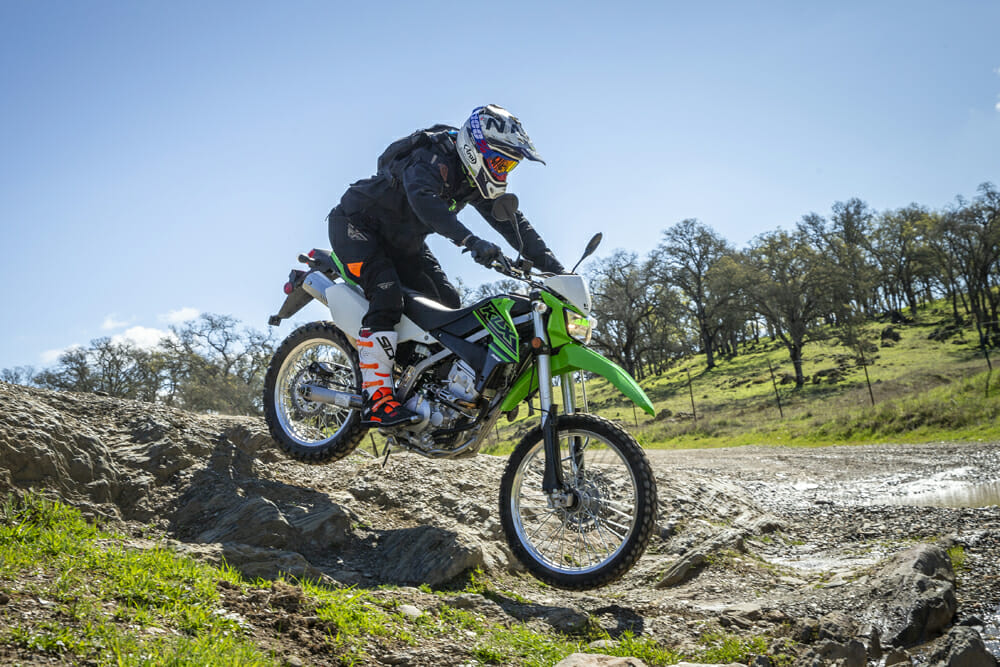 You’d be hard-pressed to see the difference between the outgoing KLX250 and the incoming KLX300, but it’s what you can’t see that counts, like the larger cylinder bore.
You’d be hard-pressed to see the difference between the outgoing KLX250 and the incoming KLX300, but it’s what you can’t see that counts, like the larger cylinder bore.
Photography by Kevin Wing
The already popular small-bore dual-sport market just got a little more exciting and will undoubtedly get even more popular with the introduction of the larger-bore Kawasaki KLX300, which replaces the previous KLX250. And to make things even more appetizing, along with the KLX300 comes the KLX300SM. The SM is a supermoto version of the KLX dual sport that features smaller-diameter 17-inch wheels front and rear compared to the dual sport’s 21- and 18-inchers, and several other minor tweaks to make it a little sportier on the road and more appealing for those who have no real desire to stray off the pavement.
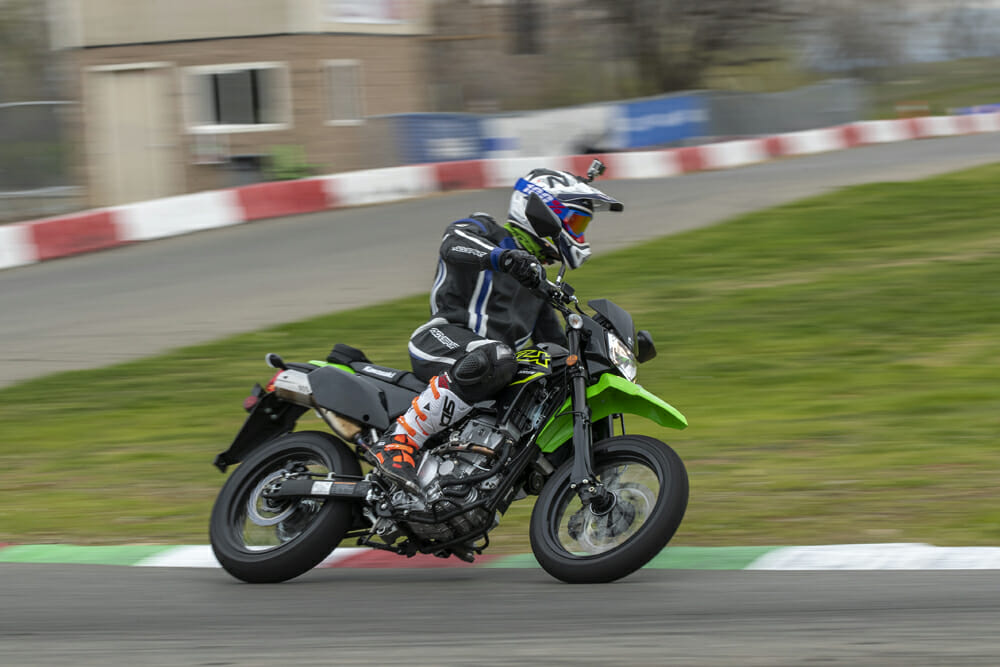 Say hello to the KLX300SM supermoto. If you like the idea of a lightweight, inexpensive dual-sport motorcycle but have no interest in straying far off the pavement, then the ultra-fun SM might be the bike for you.
Say hello to the KLX300SM supermoto. If you like the idea of a lightweight, inexpensive dual-sport motorcycle but have no interest in straying far off the pavement, then the ultra-fun SM might be the bike for you.
What’s Up?
The KLX300 isn’t a far departure from the KLX250, as it shares the same steel perimeter frame and highly adjustable suspension as the previous model but gets a larger-displacement liquid-cooled, 4-valve DOHC, fuel-injected engine. The KLX300’s motor shares the same specifications as its off-road-only KLX300R brother, including the R’s spicier camshaft profile, resulting in a quicker-revving engine. Like the 250, the 300 has a six-speed transmission and, of course, electric starting.
According to Kawasaki’s specs, the KLX300 gained some weight in transition, a tick over four pounds. Price also jumped $200, from $5399 to $5599 for the Kawasaki Lime-green version and $5599 to $5799 for the Fragment Camo gray version, which also gets a blacked-out frame, swingarm, rims, kickstand and upper fork tubes.
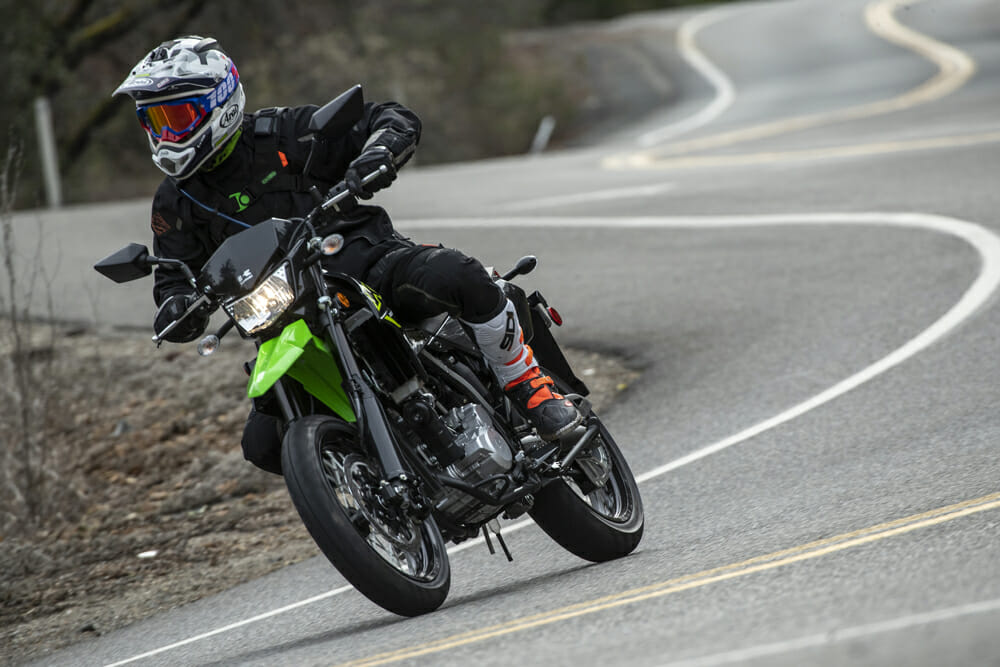 The SM is also fitted with a larger diameter front-brake rotor and firmer suspension than the dual sport. It also has less wheel travel and a lower seat height.
The SM is also fitted with a larger diameter front-brake rotor and firmer suspension than the dual sport. It also has less wheel travel and a lower seat height.
Kawasaki didn’t just slap 17-inch wheels on the SM and call it a day. The SM also got a larger front brake rotor (250 to 300mm), a steeper rake (25°) with less trail (2.8 inches), and stiffer fork and shock springs. Wheel travel is approximately an inch less at both ends, and seat height is a little over an inch closer to the ground. Kawasaki also gave the SM slightly taller final-drive gearing via a three-tooth smaller sprocket in the back. Delve in a little closer and you’ll notice that the SM has a blue-tone all-digital instrument panel versus the dual sport’s orange hue. The SM also has prettier-shaped street-bike-style mirrors and 30mm narrower handlebars.
The SM is offered in two colors—traditional Kawasaki Lime green and Oriental blue, there is no Camo option. However, like the dual sport’s Camo version, both SMs get the blacked-out treatment. There is no price difference between the green and blue SMs. Both retail for $5999.
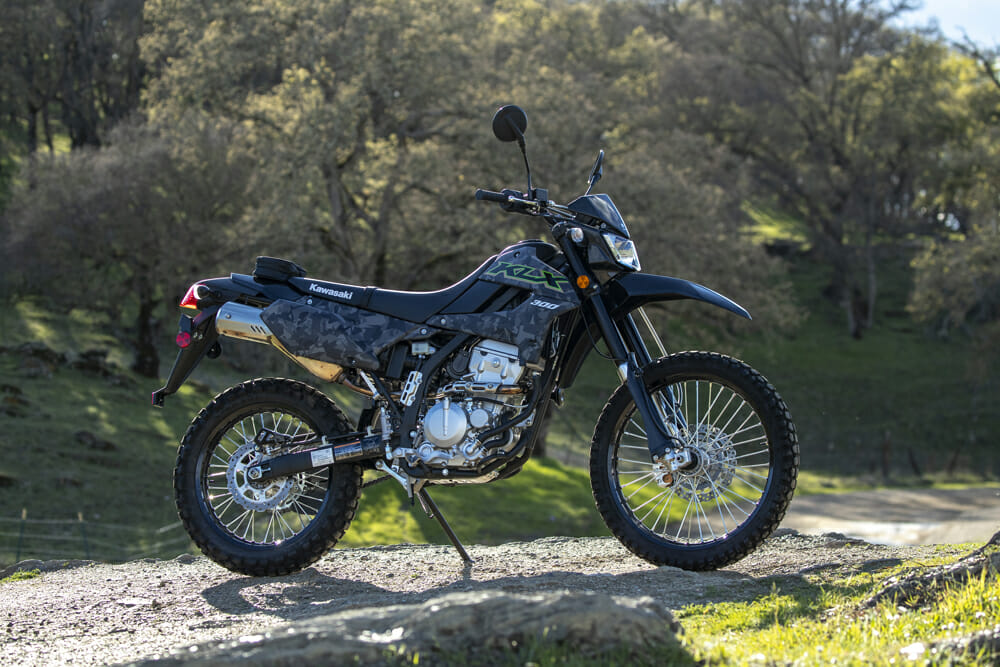 The blacked-out frame, swingarm, wheels and forks give the Camo version a more serious look.
The blacked-out frame, swingarm, wheels and forks give the Camo version a more serious look.
Kawasaki KLX300: Hit The Road
When it gets down to it, there is only one real thing to compare from the outgoing KLX250 to the incoming KLX300, and that’s power. Getting straight to the point, the difference isn’t night and day. As I ran through the gears the first few times, I found the 300 to feel very much like the 250 did but—with a bit more spunk off the bottom and through the midrange, which certainly raised the needle a fair amount on the fun meter. When it comes to low-horsepower, single-cylinder four-stroke engines in general, given a choice between having more bottom end or top end, I’ll take bottom end any day, so I’m happy with the direction Kawasaki went with the KLX300 when it comes to the motor, because, in my opinion, more bottom end (even if it’s only a small increase) equals a bump in fun, indeed.
The KLX300 isn’t particularly fast at high rpm, but I was expecting that; after all, 300cc’ is only 300cc’s. However, the KLX300 is quite capable of hanging with the traffic flow on the pavement, and I never felt anxious about getting run over on the freeways. Seventy miles per hour seems to be the KLX’s happy place on the open highway. But it can go faster, for sure. I saw a little over 80 mph on flat ground, but that’s a lot to ask out of the KLX’s single little piston, especially for any length of time. Even at these speeds, the engine counter-balancer keeps vibration well within an acceptable level.
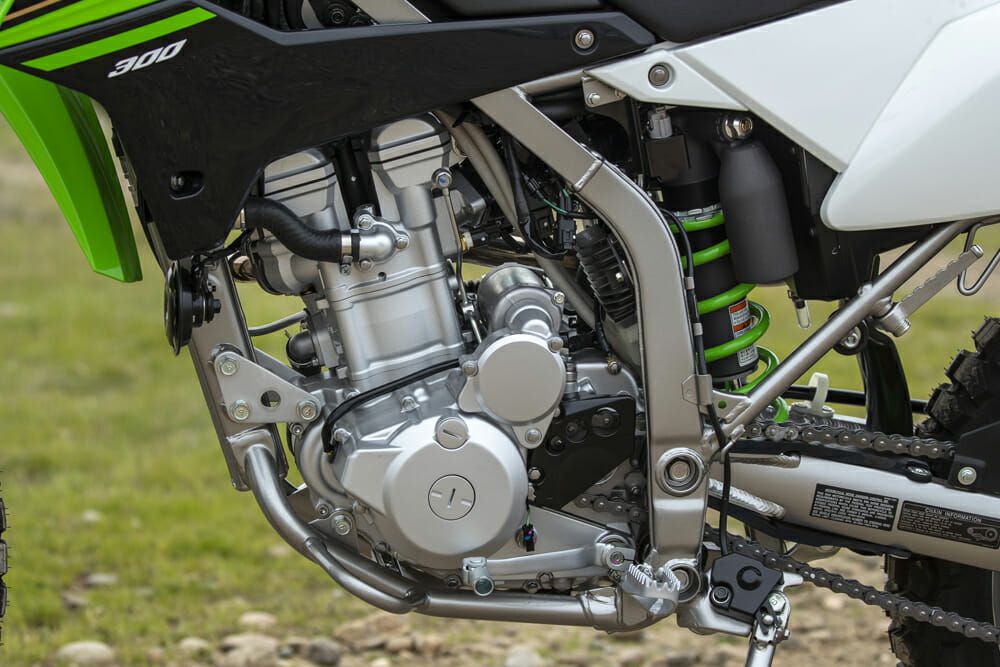 The main difference between the previous KLX250 and the KLX300 motors is the 300’s large bore and quicker-revving cam profiles. It’s essentially the same motor found in the off-road-only KLX300R.
The main difference between the previous KLX250 and the KLX300 motors is the 300’s large bore and quicker-revving cam profiles. It’s essentially the same motor found in the off-road-only KLX300R.
Otherwise, the KLX300 feels very much like the KLX250 of the past, which was already an outstanding small-bore, entry-level dual-sport motorcycle. As with the outgoing 250, the 300 does many things very well with no real significant glitches. Throttling is spot on, and cold starting hasn’t been an issue ever since Kawasaki ditched the carburetor for EFI a few years ago. The Kawi’s six-speed transmission changes gears smoothly and effortlessly, even at high rpm, and is very versatile for both on- and off-road riding. However, the shift lever is a little short for my size-12 feet, but pretty much all shift levers are. Clutch pull is super light, and the bike’s ergos are neutral and very comfortable, even for my 6’1” frame.
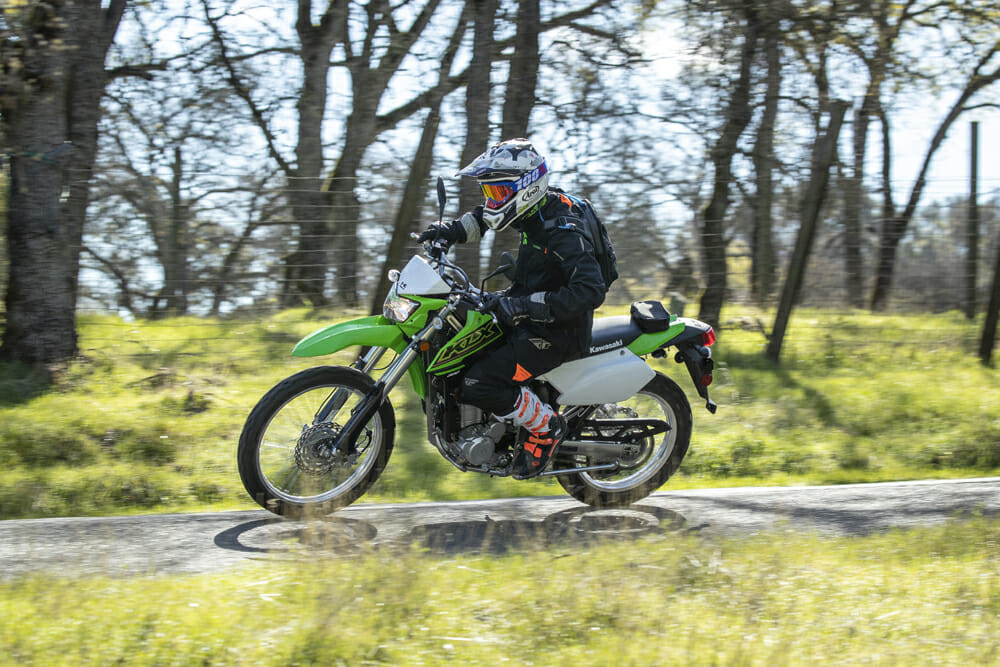
Again, like the previous 250, with the 300, you get an impressive suspension package for an entry-level motorcycle. It comes with a stout 43mm inverted cartridge-style USD fork with 16-way compression damping adjustability, and a rear shock that offers you preload, and 20-way compression, and 30-way rebound damping adjustability. You don’t usually see that kind of high-end stuff on a “budget” motorcycle. And it all works, too.
The KLX’s suspension is just plain good. It does an excellent job soaking up the small chop while having enough left over to handle the big stuff. Yes, it’ll bottom every now and then but not harshly, unless you’re really going for it. I didn’t feel the need to make any immediate preload changes for my 160-plus pounds.
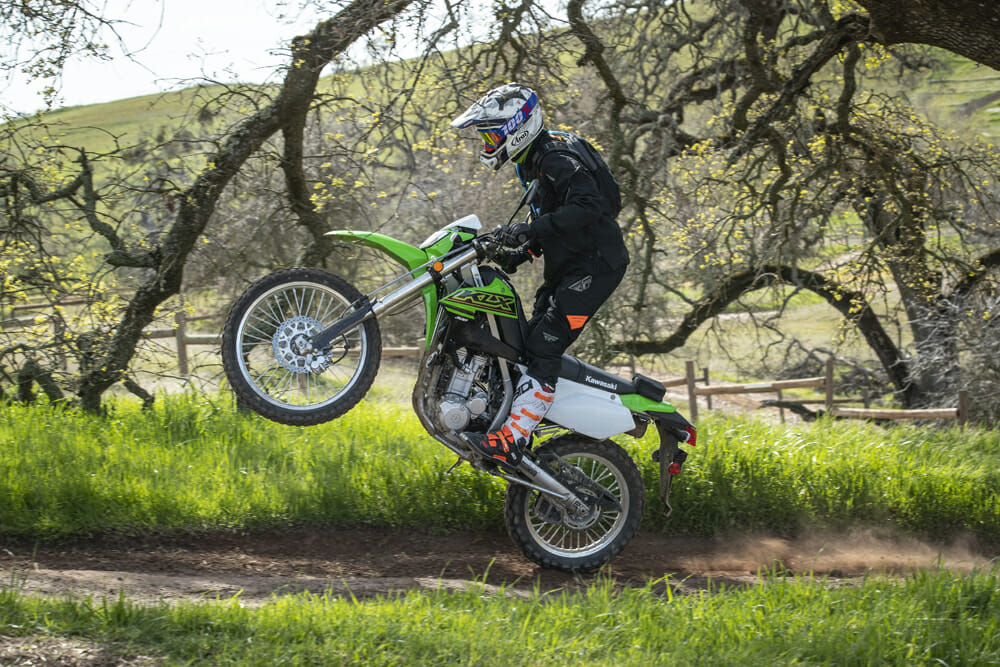 More bottom end makes getting the front wheel off the ground that much easier.
More bottom end makes getting the front wheel off the ground that much easier.
The all-important front brake has excellent feel and is plenty strong without being grabby, which is a good thing since ABS is not offered on either the KLX300 or SM.
The Dunlop D605 50/50 tires work quite well both on the road and off. From past experience, they hold up well, too.
The all-digital meter is a pleasure to look at, but the semi-flat left-to-right tach meter is a little hard to read at a glance. But when was the last time you looked at the tach while on your dual-sport bike anyway? The only info I really care about on the fly is the speedo, which has a large readout, so I’m good. And I like the dual trip meters.
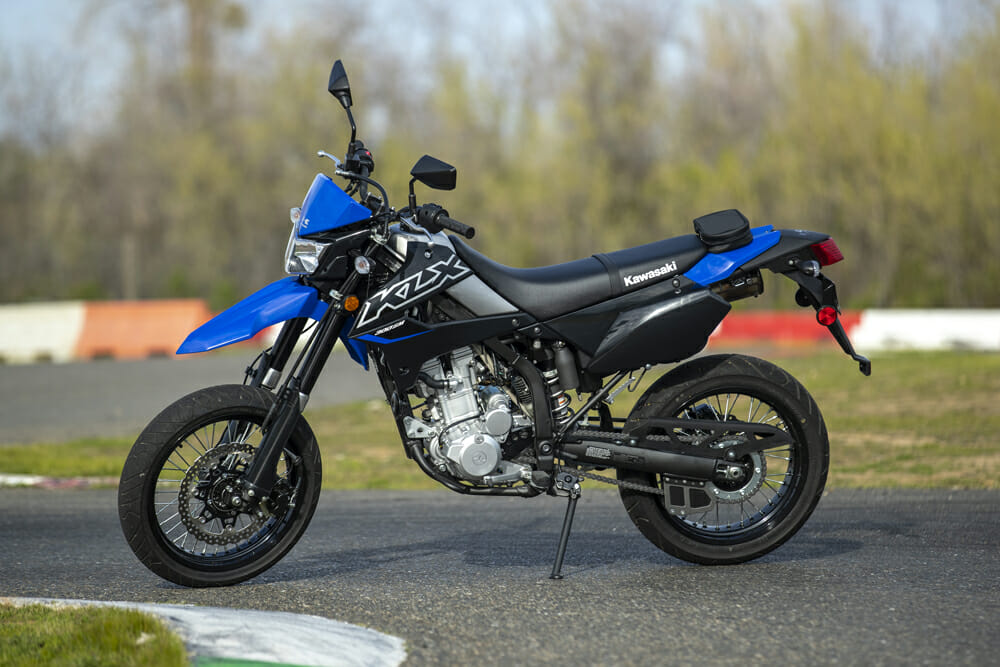 In addition to the standard Kawasaki Lime green, the SM is also available in blue. Both versions get the blacked-out treatment.
In addition to the standard Kawasaki Lime green, the SM is also available in blue. Both versions get the blacked-out treatment.
Kawasaki KLX300SM: Change of Pace
The KLX300SM feels distinctively smaller in size compared to the dual sport. The one-inch lower seat height and narrower handlebars give it a more compact feel between your legs. Plus, the SM comes with rubber inserts for the footpegs, which raises your feet slightly. Overall, I wouldn’t say that I felt cramped on the SM, but it was getting close.
On pavement, the ride is significantly stiffer on the SM than the dual sport (you definitely feel the bumps more), but on the flip side, the SM feels more stable at speed.
The 17-inch wheels also give the SM a much snappier-handling feeling. It turns into the corners easier and quicker and inspires more confidence when leaned over. This can also be attributed to those fat IRC Road Winner RX-01 tires that grip the asphalt noticeably better than the dual sport’s skinnier semi-knobby Dunlop D605 tires that wallow around a bit on the pavement when speeds pick up. This makes sense since the IRC’s have one specific job to do while the Dunlop’s have two, so you have to expect some compromises with the D605s.
The SM’s taller gearing is also nicer for the road. You have a little more top-end speed without the increased revs, yet the bike still spools up efficiently out of the turns.
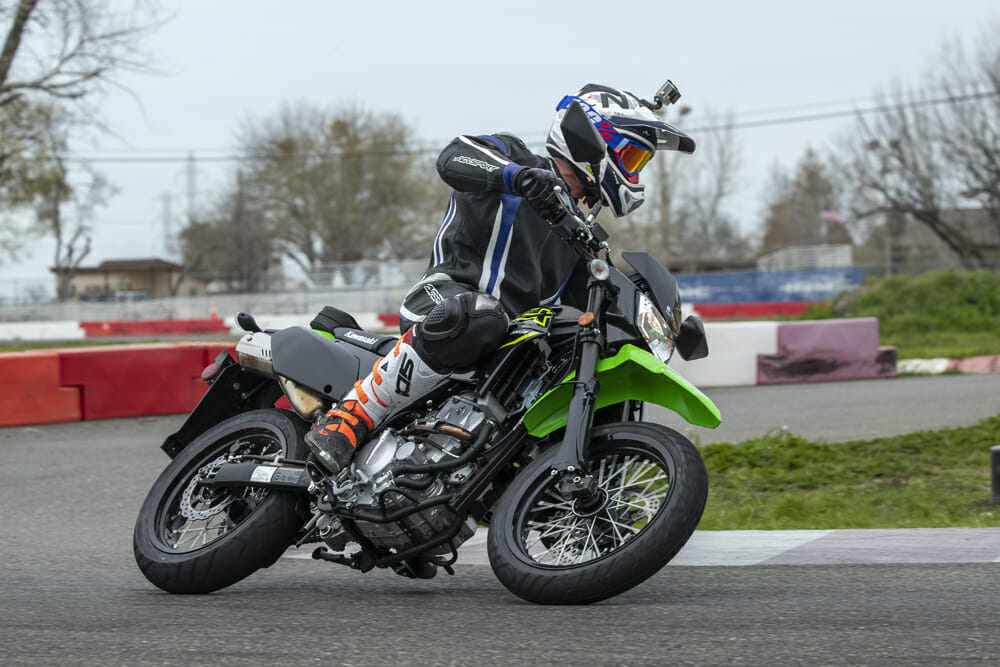
While the SM is a blast to ride on the twisties and even around town, it is the most fun on the track. If you’ve have never tried supermoto, you really need to. It should be on every motorcyclist’s bucket list, and the KLX300SM is a great way to get your feet wet. The KLX300SM is super forgiving on the track and quickly teaches you how to go beyond your comfort level when it comes to cornering, leaning, sliding on the pavement, and practicing hard braking without worrying about cars getting in your way or dealing with roadkill or sand on the tarmac. It’ll make you a better rider in just a few hours.
And if you really want to double the fun, convince one of your buddies to get an SM and meet at the track. It’s good cheap fun dicing with someone on equal equipment. Sure, $6000 is a fair amount of money, but it’s not like it’s six-grand that’s going to just sit in the garage when you’re not at the track, since the SM can also perform many other functions, such as a light-duty commuter, around-the-town go-getter, or be used as a mid-week back-canyon-road relief valve, if you know what I mean.
But if dirt is more your thing, the KLX300 dual sport will do the trick, as well.
Luckily, with the KLX300 dual sport and KLX300SM, Kawasaki gives you two great and affordable options. CN
VIDEO | 2021 Kawasaki KLX300 and KLX300SM Review
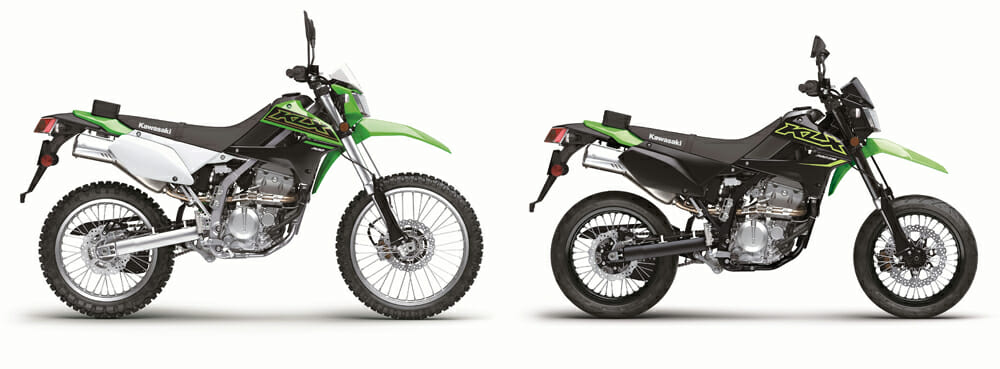
2021 Kawasaki KLX300 / KLX300SM Specifications
| MSRP: |
$5599-$5799 / $5999 |
| Engine: |
Liquid-cooled, 4-stroke, single |
| Valvetrain: |
4-valve, DOHC |
| Bore: |
78.0mm |
| Stroke: |
61.2mm |
| Displacement: |
298cc |
| Compression ratio: |
11.1:1 |
| Fuel system: |
DFI w/ 34mm throttle body |
| Ignition: |
Digital DC-CDI |
| Transmission: |
6-speed |
| Gearing: |
14T/40T / 14T/37T |
| Rake: |
26.7° / 25.0° |
| Trail: |
4.2 in. / 2.8 in. |
| Front-wheel travel: |
10.0 in. / 9.1 in. |
| Rear-wheel travel: |
9.1 in. / 8.1 in. |
| Front Tire Size: |
3.00 x 21 in. / 110 x 17 in. |
| Rear Tire Size: |
4.60 x 18 in. / 130/70 x 17 in. |
| Front suspension: |
43mm inverted cartridge fork w/ 16-way compression damping adj. |
| Rear suspension: |
Uni-Trak w/ adjustable preload, 16-way compression and rebound damping adj. |
| Fork springs: |
7.8 N/mm / 10.8 N/mm |
| Shock spring: |
54 N/mm / 66.6 N/mm |
| Wheelbase: |
56.7 in. / 56.5 in. |
| Front brake: |
250mm petal disc / 300mm petal disc |
| Rear brake: |
240mm petal disc |
| Fuel capacity: |
2.0 gal. |
| Ground clearance: |
10.8 in. / 9.3 in. |
| Seat height: |
35.2 in. / 33.9 in. |
| Curb weight: |
302.1 lbs. / 304.03 lbs. |
| Colors: |
Lime Green & Fragment Camo Gray / Lime Green & Oriental Blue |
| Warranty: |
12 months |
